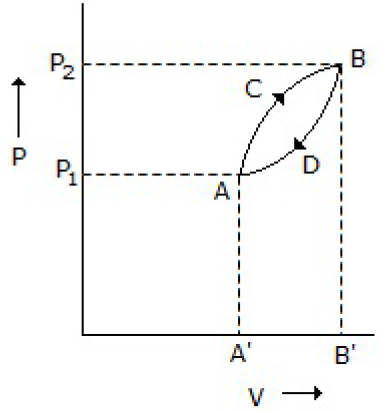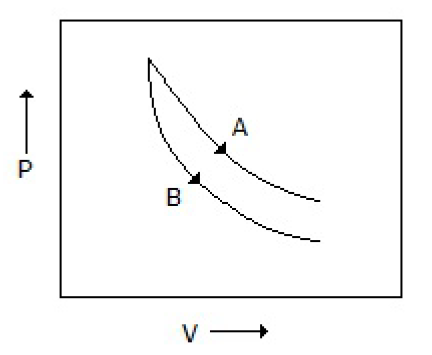Reduced pressure of a gas is the ratio of its
Pressure to critical pressure
Critical pressure to pressure
Pressure to pseudocritical pressure
Pseudocritical pressure to pressure
Correct Answer :
A. Pressure to critical pressure
Related Questions
In reactions involving solids and liquids (where change in volume is negligible), the heat of reaction at constant pressure as compared to that at constant volume is
More
Less
Same
Unpredictable; depends on the particular reaction
The four properties of a system viz. P, V, T, S are related by __________ equation.
Gibbs-Duhem
Gibbs-Helmholtz
Maxwell's
None of these
Change of heat content when one mole of compound is burnt in oxygen at constant pressure is called the
Calorific value
Heat of reaction
Heat of combustion
Heat of formation
Air enters an adiabatic compressor at 300K. The exit temperature for a compression ratio of 3, assuming air to be an ideal gas (Y = Cp/Cv = 7/5) and the process to be reversible, is
300 × (32/7)
300 × (33/5)
300 × (333/7)
300 × (35/7)
What happens in a reversible adiabatic expansion process?
Heating takes place
Cooling takes place
Pressure is constant
Temperature is constant
Extensive properties of a thermodynamic system depend upon the __________ of the system.
Specific volume
Temperature
Mass
Pressure
All gases except __________ shows a cooling effect during throttling process at atmospheric temperature and pressure.
Oxygen
Nitrogen
Air
Hydrogen
In a P-V diagram (for an ideal gas), an isothermal curve will coincide within adiabatic curve (through a point), when
Cp < Cv
Cp = Cv
Cp > Cv
C ≥ Cv
Which of the following is a thermodynamic property of a system?
Concentration
Mass
Temperature
Entropy
If the molar heat capacities (Cp or Cv) of the reactants and products of a chemical reaction are identical, then, with the increase in temperature, the heat of reaction will
Increase
Decrease
Remain unaltered
Increase or decrease; depends on the particular reaction
Generation of heat by friction is an example of a/an __________ change.
Isothermal
Irreversible
Adiabatic
Reversible
A refrigerator may be termed as a
Heat pump
Heat engine
Carnot engine
None of these
Joule-Thomson effect i.e., a throttling process is a constant __________ process.
Entropy
Temperature
Internal energy
Enthalpy
Pick out the wrong statement.
A refrigeration cycle violates the second law of thermodynamics
Refrigeration cycle is normally represented by a temperature vs. entropy plot
In a refrigerator, work required decreases as the temperature of the refrigerator and the temperature at which heat is rejected increases
One ton of refrigeration is equivalent to the rate of heat absorption equal to 3.53 kW
On a P-V diagram of an ideal gas, suppose a reversible adiabatic line intersects a reversible isothermal line at point A. Then at a point A, the slope of the reversible adiabatic line (∂P/∂V)s and the slope of the reversible isothermal line (∂P/ ∂V)T are related as (where, y = Cp/Cv)
(∂P/∂V)S = (∂P/∂V)T
(∂P/∂V)S = [(∂P/∂V)T]Y
(∂P/∂V)S = y(∂P/∂V)T
(∂P/∂V)S = 1/y(∂P/∂V)T
4 kg moles of an ideal gas expands in vacuum spontaneously. The work done is
4 J
∞
0
8 J
Number of components (C), phase (P) and degrees of freedom (F) are related by Gibbs phase rule as
P + F - C = 2
C = P - F + 2
F = C - P - 2
P = F - C - 2
In the equation, PVn = Constant, if the value of n = 0, then it represents a reversible __________ process.
Isobaric
Isothermal
Isentropic
Isometric
A thermodynamic system is taken from state A to B along ACB and is brought back to A along BDA as shown below in the P-V diagram. The net work done during the complete cycle is given by the area covered by

P1ACBP2P1
ACBB1A1A
ACBDA
ADBB1A1A
Melting of ice exemplifies a/an
Adiabatic process
Endothermic reaction
Exothermic reaction
Process involving a chemical reaction
Consider the process A & B shown in the figure given below: In this case, it is possible that

Both the processes are adiabatic
Both the processes are isothermal
Process A is isothermal while B is adiabatic
Process A is adiabatic while B is isothermal
Entropy change for an irreversible isolated system is
∞
0
< 0
> 0
Pick out the wrong statement.
The net change in entropy in any reversible cycle is always zero
The entropy of the system as a whole in an irreversible process increases
The entropy of the universe tends to a maximum
The entropy of a substance does not remain constant during a reversible adiabatic change
Equilibrium constant of a reaction varies with the
Initial concentration of the reactant
Pressure
Temperature
None of these
For the gaseous phase chemical reaction, C2H4(g) + H2O(g) ↔ C2H5OH(g), the equilibrium conversion does not depend on the
Steam to ethylene ratio
Temperature
Pressure
None of these
As pressure approaches zero, the ratio of fugacity to pressure (f/P) for a gas approaches
Zero
Unity
Infinity
An indeterminate value
The intensive properties are
Molar volume, density, viscosity and boiling point
Refractive index and surface tension
Both (A) and (B)
None of these
For a cyclic process, a fixed ratio between heat and work
Always exists
May exist
Never exists
Is difficult to predict
There is a change in __________ during the phase transition.
Volume
Pressure
Temperature
All a, b & c
Which of the following liquid metals has the highest thermal conductivity?
Molten sodium
Molten lead
Mercury
Molten potassium
